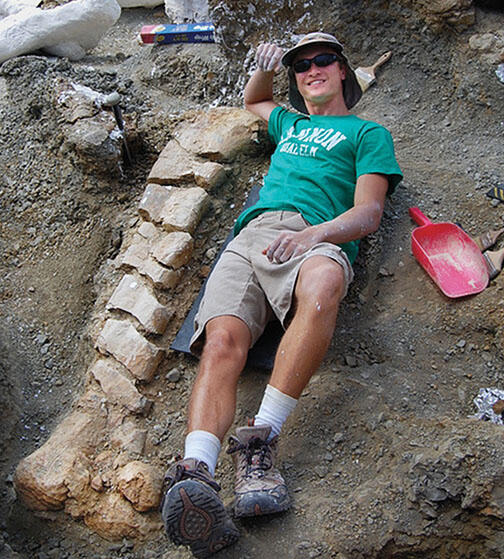Old Bones, New Insights
Princeton senior’s dinosaur research may provide evidence of sexual selection
A Princeton senior has gained attention for breaking new ground in the study of dinosaurs, providing evidence that among a species of Stegosaurus, males and females had differently shaped bony back plates.
Evan Saitta ’14 — who says he has been fascinated by dinosaurs since childhood — made the discovery as part of senior-thesis research that has taken him from a Swiss museum to excavation sites in Utah and Montana. His subject is a northerly species of the elephant-sized Stegosaurus, one of the most recognizable of all dinosaurs because of its distinctive rows of ornamental back plates.
The project was sparked by the enigmatic presence of two different types of back plates at a central Montana quarry, where he has helped to dig Stegosaurus fossils for the last five years. One type is long and ovular; the other is tall and triangular.
For years, this pattern puzzled volunteers at the Montana site, which is run by the Judith River Dinosaur Institute. Two summers ago, Saitta had an idea: Perhaps one type belongs to females, the other to males. In biology, such a difference in a trait is known as sexual dimorphism; though it is prevalent among living animals, paleontologists have had difficulty proving it in fossilized animals.
To confirm his hypothesis, Saitta first had to rule out other possible explanations. He knew that the plates could not belong to two separate species because the quarry is populated by only one species: Stegosaurus mjosi. He also had to eliminate the possibility that one form was non-mature and would grow into the other form.
This proved to be tricky. To determine the age of S. mjosi, paleontologists examine the back plate for internal vascular piping, which is indicative of sexual maturity. However, to perform that analysis, Saitta needed specialized equipment such as a CT scanner.
So he approached the Billings (Mont.) Clinic, which agreed to provide normally expensive CT scans for free. “That’s the type of guy he is,” said Saitta’s thesis adviser, Professor James Gould. “He sweeps you along with his enthusiasm.”
The scan showed the presence of the piping within the back plates, proving that both types of plates belonged to sexually mature individuals and confirming Saitta’s idea that the different plates belonged to dinosaurs of different genders.
But which is which? A fossilized tibia found near the tall triangular plates at the Montana site may shed light on this question, Saitta suggested. In preparation for laying eggs, female birds deposit a type of tissue in their long bones that acts as a calcium reservoir when it comes time to produce eggs. Similar tissue has been found in dinosaur bones. Saitta will examine a thin slice of the tibia to see if the tissue is present — and if it is, it may suggest that the tall plates belong to females, he said.
Saitta, who plans to publish his findings after further microscopic work and mathematical analysis, said the study of dinosaurs is “the perfect challenge. ... As we’re finding more fossils and gathering more evidence, we’re starting to answer questions that previously we wouldn’t have been able to.”
Saitta’s research implies sexual selection among dinosaurs, and the nature of the dimorphism indicates that it was a system of female mating choice, Gould said. That would be exciting, “since it’s a rarer and more highly evolved social system,” he said.
“Actually, knowing anything about the social system of a species that’s been extinct for tens of millions of years is amazing,” Gould said.













No responses yet